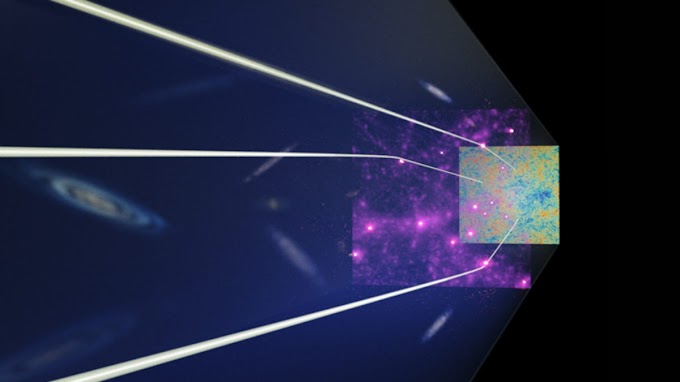It’s been an amazing couple of weeks for fanatics of gravitational lensing. James Webb Space Telescope (JWST) grabbed the headlines with a superb infrared view of lensing inside the SMACS 0723 picture, and that had everyone speak. Yet, seeing gravitationally lensed items is not new. Some may be seen from the ground, and of route, Hubble Space Telescope (HST) has been cranking out views of gravitational lensing for years.
Just some days in the past, HST launched every other one. It’s a putting view of galaxy known as SGAS J143845+145407. It’s the center-piece of the HST view and looks two times in a reflect picture of itself. The galaxy seems a 3rd time, as a totally smeared apparition that makes a “bridge” between the alternative two pictures.
 |
| Credit : NASA |
Deconstructing the Lensing of SGAS J143845+145407
So, what are we seeing in the HST image? This triple-imaged item is from a set of Hubble observations that use gravitational lensing to see inner galaxies in the early Universe. It works due to the fact the mild from those remote galaxies is curved or “bent” by way of the gravitational impact of a galaxy cluster that lies among HST and its objectives. The cluster is called the “lens” and the distant galaxy, in this example, SGAS J143845+145407, is the “lensed object”.
Gravitational lensing can do humorous matters to the arrival of the lensed object. It can smear the photo, distort it, and—if the geometry lines up just proper—create more than one images of it. Finally, gravitational lensing can amplify the view of the lensed object. And, that’s critical because most of the time those distant items could be too a long way away or too faint to be located.
The lensing famous information of remote galaxies, inclusive of the existence of spiral arms or celebrity start regions, which allows astronomers to decide star formation in early galaxies. This in turn offers scientists higher perception into how the general evolution of galaxies has opened up over time.
 |
| A close-up view shows more detail in the twin images of the lensed galaxy. The third image is the same galaxy smeared out between the other two images. Courtesy: NASA/ESA/STScI |
About Galaxy SGAS J143845+145407
The triply imaged galaxy in the HST photograph is technically known as a luminous infrared galaxy (LIRG, for quick). A traditional LIRG can be as vivid as 100 billion times the luminosity of our Sun. Typically, these galaxies are spirals and their infrared luminosity stems from lively regions of celebrity formation. Many of them create around one hundred new stars consistent with 12 months. For evaluation, the Milky Way creates (on average) one new celebrity in keeping with year.
Thanks to the big name formation (and possibly the presence of energetic galactic nuclei), LIRGs are brighter in infrared mild than in optical light. That’s because their visible mild receives absorbed by using fuel and dirt within the galaxies. The dust then re-radiates thermal strength, which is first-class visible inside the infrared spectrum. Two of HST’s units, the Advanced Camera for Surveys, and the Wide Field Camera 3, had been used to picture the object, and take spectra for further special have a look at.
This galaxy lies approximately 6.9 billion years far from us. Its light turned into lensed via a galaxy cluster simplest 2.8 billion years away. To get the lensed photographs of SGAS J143845+145407, it had to be lined up exactly at the back of the cluster from Hubble’s point of view.
 |
| Credit : NASA |
What Did Astronomers Learn about this Galaxy?
The crew of astronomers who centered HST in this galaxy determined that the magnified view of SGAS J143845+145407 allowed them to get information about megastar formation in that galaxy. Without lensing, seeing this galaxy is challenging. Since it's far lensed, astronomers can look at character big name formation regions at a quite high resolution. It turns out the superstar birth interest takes location over huge areas inside the galaxy. In addition, astronomers were able to truly parent a two-arm structure within the galaxy. They time period it a “grand design” spiral, which means that it has nicely-defined arms. This galaxy additionally has a totally crimson core and bluer clumps of emissions scattered throughout the spiral arms.
The huge quantities of famous person formation on this galaxy’s spiral fingers endorse strongly that most (if not all) LIRGs have huge-spread (maybe even galaxy-extensive) bursts of superstar formation. If you compare these to galaxies inside the present-day universe, the distinction is putting. The neighborhood universe galaxies can have very excessive knots of star formation, however they are smaller in scale than the megastar-forming areas inside the LIRGs.
 |
| Credit : NASA |
Lensing for the Win
HST and JWST will stay the units of preference for studying lensed gadgets in the distant universe. While some are studied from the floor, the very distant ones in the early universe want the strength of orbiting telescopes.










